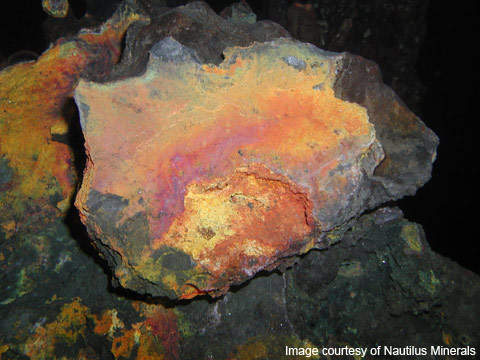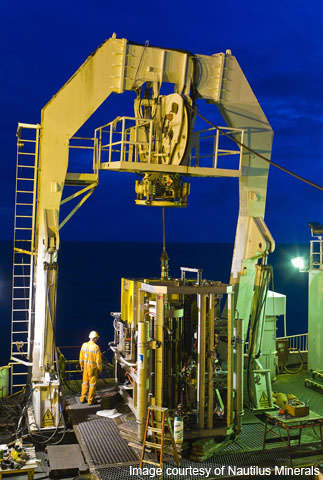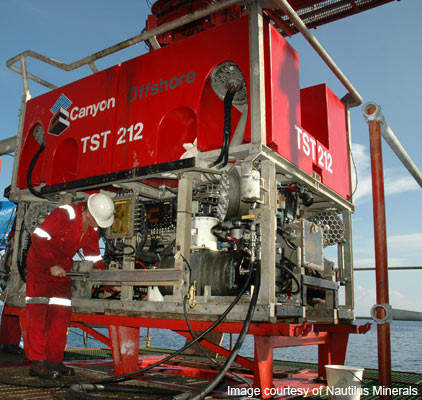The Solwara 1 project is located in the territorial waters of Papua New Guinea (PNG). Nautilus Minerals Niugini, a subsidiary of Nautilus Minerals, has been exploring the deposit site since 2005. The deposit contains base metal sulphides, gold and silver.
In July 2007, Nautilus announced it would take over the offshore development aspects of the Solwara 1 project following the lapse of an agreement with Belgium-based Dredging Company.
The area covered by the Solwara 1 deposit is only 0.112km², approximately the size of 15 rugby fields.
The Solwara 1 project development includes the recovery of high-grade seabed sulphide (SMS) deposits from the floor of the Bismarck Sea, a major resource of base metal sulphides, gold and silver.
The project has been explored by ROV, bathymetric surveys, surface sampling and core drilling.
The hydrothermal field of the Solwara 1 project area was first discovered by Australia’s Commonwealth Scientific and Industrial Research Organisation during 1996.
Recent developments
Between January and April 2009, a commercial review of Solwara 1 was carried out to identify potential capital and operating cost savings in regards to the global financial downturn. Shipping market enquires were also investigated to identify various mining support vessel options.
In May 2009, Nautilus discovered a new high grade base and precious metal zone 250m north of the project area. The new zone has been evaluated with top vales in respect of each mineral of 30.1% Cu, 22.0% Zn, 26.2 g/t Au and 580 g/t Ag across holes drilled.
The company is assessing tenders for further drilling in these new areas and parts of deposits which remain open at depth. It is subject to availability of equipment with minimum 40m depth capability for carrying out further drilling in 2010.
Nautilus CEO Stephen Rogers said: “The discovery of new high-grade mineralisation on our EL1196, near the existing NI43-101 compliant resource at Solwara 1, is an important result. It further demonstrates the exploration potential on both MLA154 and our large tenement package in the Bismarck Sea. The company continues to progress towards production, and we look forward to testing the depth potential of these newly discovered mineralised zones once we award a drilling contract at the conclusion of the current tender process.”
Drilling
The company conducted a six-month field campaign at Solwara 1 during 2007 in which further chimney sampling and a comprehensive diamond drilling programme was completed with the use of submersible drill rigs scaled up on ROVs. The core recovery averaged above 70% from massive sulphide zone and showed the continuity of sulphide mineralogy across the Solwara 1 deposit. Considerable gold and silver mineralisation also occurred within the massive sulphides.
The 21-day scout drilling programme, covering 176,40m, was completed on 3 December 2008. Out of 31 holes drilled, 22 were drilled on EL 1196, including four holes at Solwara 5.
Drilling results
Three holes – SD 148, 149 and 162 – were drilled around 250m north of the central zone, while a new zone was discovered in the north. The holes have been drilled around the existing inferred resource at Solwara 1 to check the robustness of the existing resource model.
Sea-floor mapping
The seabed at Solwara 1 was mapped in 2006 and 2007 by video camera fly-over using ROVs. A map of the extent of the main chimney field was complied from video footage which was used to find out targets for core drillings.
Geology and reserves
Description of the geology was observed and interpreted largely from the 2007 drilling results. The drilling results showed that the geology was consistent across the deposit. SMS deposits at Solwara Project 1 are formed in extensional fault systems which facilitate the deep circulation of seawater by way of convection cells formed in response to increased heat flow associated with submarine volcanic activity.
Mineralisation
The deposit is formed of various massive sulphide bodies over which fields of sulphide-rich chimneys are developed.
The current mineralisation zone is around 1.3km long and up to 200m wide. It has been drilled up to 19m below the seabed.
Environmental impact
An environmental impact statement for the Solwara Development was submitted by Nautilus to the Department of Environment and Conversation at the end of Quarter 3 2008. The statement’s key findings said that Solwara 1 can be developed with minimal impact on communities.






